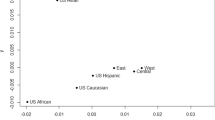Abstract
Length variation at the short tandem repeat (STR) locus HUMTH01 can be reliably detected from small amounts of DNA (0.01–10 ng) extracted from a range of forensic human samples, using the polymerase chain reaction (PCR), horizontal polyacrylamide gels and silver staining. It was shown that the oligonucliotide primers used are specific to humans and some higher primates. Population data bases of Caucasians and Asians living in Victoria (Australia) were constructed and the differences in allele frequencies between Caucasians and Asians confirmed. A new allele provisionally designated HUMTHO1*12 was identified. The discrimination power provided by this locus (0.86–0.91) has been used effectively in a range of forensic case studies.
Zusammenfassung
Längenvariabilität am Short Tandem Repeat (STR) Lokus HUMTHOI läßt sich anhand geringer DNA-Mengen (0.01–10 ng), aus einer Reihe forensischer Proben menschlichen Ursprungs extrahiert, mittels Polymerase-Kettenreaktion (PCR), horizontaler Polyacrylamidgele und Silberfärbung verläßlich detektieren. Gezeigt wurde, daß die benutzten Oligonukleotidprimer, mit Ausnahme einiger höherer Primaten, humanspezifisch sind. Es wurden Populationsdatenbanken von Kaukasiern und Asiaten aus Victoria (Australien) erstellt und die Unterschiede in den Allelfrequenzen zwischen Kaukasiern und Asiaten bestätigt. Ein neues, vorläufig als HUMTH01*12 bezeichnetes Allel wurde identifiziert. Das Diskriminationsvermögen, welches dieser Lokus bietet (0.86–0.91), ist in einer Reihe forensischer Fallstudien effectiv eingesetzt worden.
Similar content being viewed by others
References
Boerwinkle E, Xiong W, Fourest E, Chan L (1989) Rapid typing of tandemly repeated hypervariable loci by the polymerase chain reaction: application to the apolipoprotein B3 hypervariable region. Proc Natl Acad Sci USA 86:212–216
Budowle B, Chakraborty R, Giusti AM, Eisenberg AJ, Allen RC (1991) Analysis of the VNTR locus D1S80 by the PCR followed by high-resolution PAGE. Am J Hum Genet 48:137–144
Edwards A, Civitello A, Hammond HA, Caskey CT (1991) DNA-typing and genetic mapping with trimeric and tetrameric tandem repeats. Am J Hum Genet 49:746–756
Edwards A, Hammond HA, Jin L, Caskey T, Chakraborty R (1992) Genetic variation at five trimeric and tetrameric tandem repeat loci in four human population groups. Genomics 12:241–253
Gill P, Kimpton C, D'Aloja E, Andersen JF, Bar W, Brinkmann B, Holgersson S, Johnsson V, Kloosterman AD, Laren MV, Nellemann L, Pfitzinger H, Phillips CP, Schmitter H, Schneider PM, Stenersen M (1994) Report of the European DNA profiling group (EDNAP) - towards standardisation of short tandem repeat (STR) loci. Forensic Sci Int 65:51–59
Gutowski S, Oorschot RAH van, Robinson S (1994) D1S80 typing in the State of Victoria. Proceedings of the 13th Meeting of the International Association of Forensic Sciences, Düsseldorf 1993 (in press)
Hagelberg E, Sykes B, Hedges R (1989) Ancient bone DNA amplified. Nature 342:485
Hochmeister MN, Budowle B, Jung J, Borer UV, Comey CT, Dirnhofer R (1991a) PCR-based typing of DNA extracted from cigarette butts. Int J Leg Med 104:229–233
Hochmeister MN, Budowle B, Borer UV, Eggmann U, Comey CT, Dirnhofer R (1991b) Typing of deoxyribonucleic acid (DNA) extracted from compact bone from human remains. J Forensic Sci 36:1649–1661
Horn GT, Richards B, Klinger KW (1989) Amplification of a highly polymorphic VNTR segment by the polymerase chain reaction. Nucleic Acids Res 17:2140
Kanter E, Baird M, Shaler R, Balazs I (1986) Analysis of restriction fragment length polymorphisms in deoxyribonucleic acid (DNA) recovered from dried bloodstains. J Forensic Sci 31:403–408
Kasai K, Nakamura Y, White R (1990) Amplification of a variable number of tandem repeats (VNTR) locus (pMCT118) by the polymerase chain reaction (PCR) and its application to forensic science. J Forensic Sci 35:1196–1200
Kloosterman AD, Budowle B, Daselaar P (1993) PCR-amplification and detection of the human D1S80 VNTR locus. Int J Leg Med 105:257–264
Ludwig EH, Friedl W, McCarthy BJ (1989) High-resolution analysis of a hypervariable region in the human apolipoprotein B gene. Am J Hum Genet 45:458–464
Mourant AE, Kopeć AC, Domaniewska-Sobczak K (1976) The distribution of human blood groups and other polymorphisms, 2nd edn. Oxford University Press, London
Puers C, Hammond HA, Jin L, Caskey CT, Schumm JW (1993) Identification of repeat sequence heterogeneity at the polymorphic short tandem repeat locus HUMTH01[AATG]n and reassignment of alleles in population analysis by using a locus-specific allelic ladder. Am J Hum Genet 53:953–958
Rand S, Puers C, Skowasch K, Wiegand P, Budowle B, Brinkmann B (1992) Population genetics and forensic efficiency data of 4 AMPFLP's. Int J Leg Med 104:329–333
Sajantila A, Budowle B, Strom M, Johnsson V, Lukka M, Peltonen L, Ehnholm C (1992) PCR amplification of alleles at the D1S80 locus: comparison of a Finnish and a North American Caucasian population sample, and forensic casework evaluation. Am J Hum Genet 50:816–825
Sokal R, Rohlf J (1969) Biometry, 2nd edn. WH Freeman, New York
Sullivan KM, Pope S, Gill P, Robertson JM (1992) Automated DNA profiling by fluorescent labelling of PCR products. PCR Methods Appl 2:34–40
Author information
Authors and Affiliations
Rights and permissions
About this article
Cite this article
van Oorschot, R.A.H., Gutowski, S.J. & Robinson, S.L. HUMTH01: Amplification, species specificity, population genetics and forensic applications. Int J Leg Med 107, 121–126 (1994). https://doi.org/10.1007/BF01225598
Received:
Revised:
Issue Date:
DOI: https://doi.org/10.1007/BF01225598



